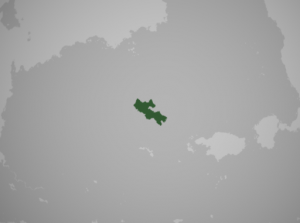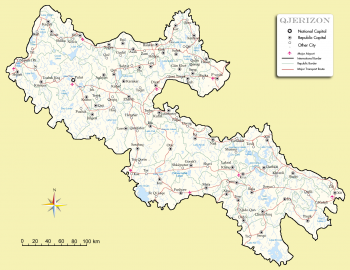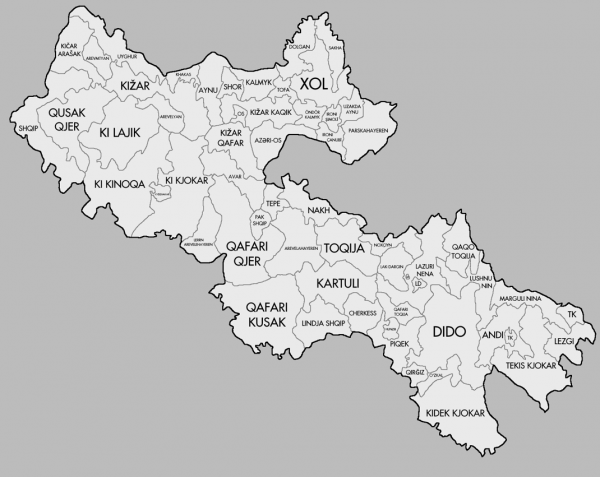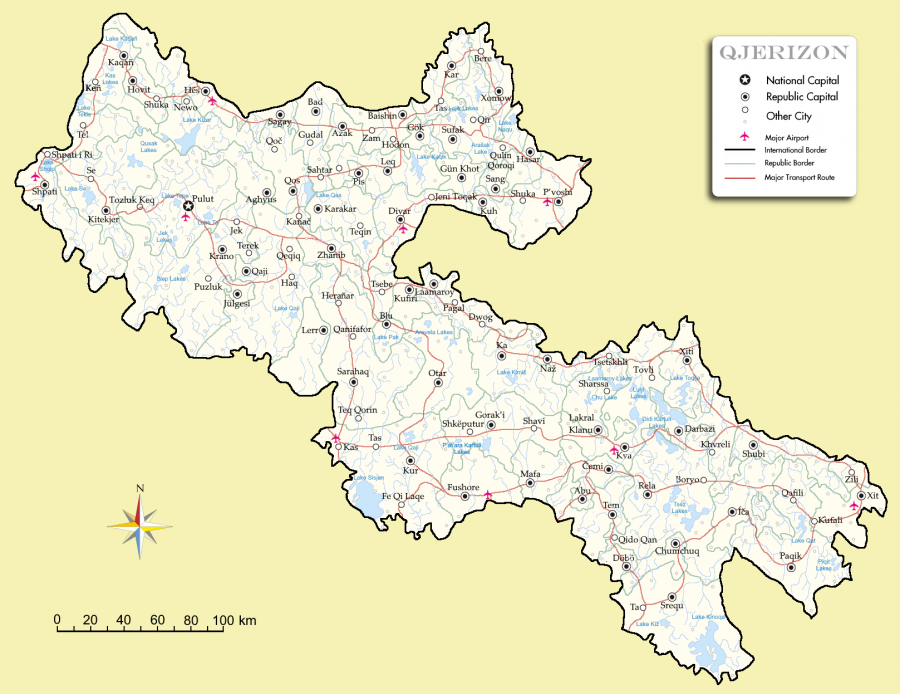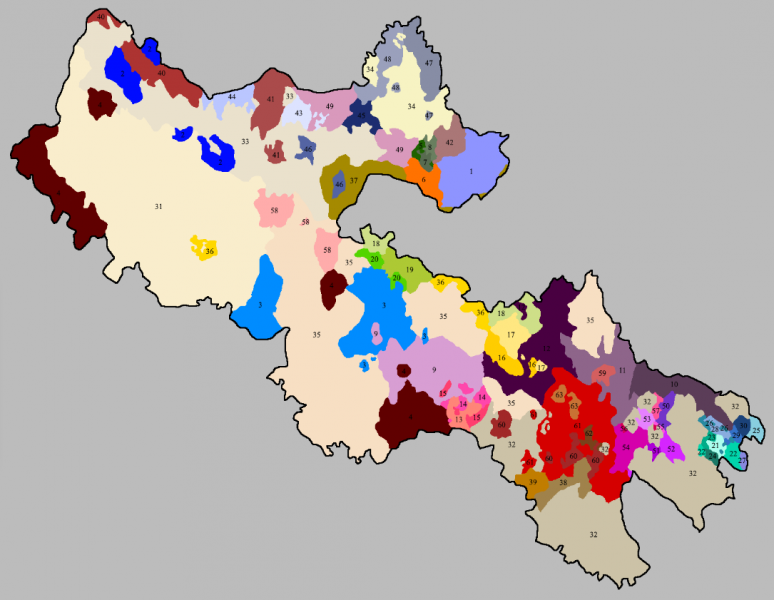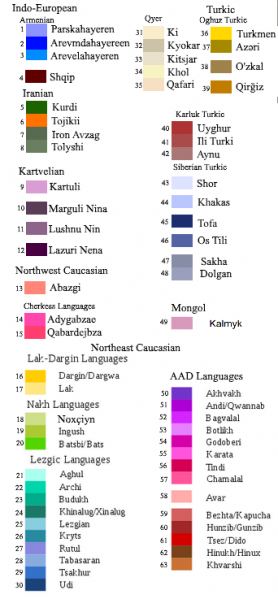Yeristan
Serene Confederation of Qjer Republics Xurul Xuruqaj Iň Xakaqik Qjer | |
|---|---|
|
Flag | |
Motto: "Qišin Haqar Qahli" "For All Peoples" | |
| Location | Yeristan is located just above the equator in Central Cancodia. |
| Capital and largest city | Pulut |
| Official languages | None at the national level |
| Ethnic groups | 63 Distinct Entholinguistic Groups Recognized, Ethnolinguistic Groups of Yeristan |
| Demonym(s) | Yeri/Qjer |
| Government | Semi-Presidential Confederation |
• Xakan | Kajra Rekjokar |
| Koturyo Magalaqu | |
| Qalekaner Mwiq | |
| Legislature | Yeri Legislature |
| Xuruqaj | |
| Rek Pulut | |
| Established | |
• Republic Formed | 5th Century BCE |
• Rek Pulut Created | 188 CE |
• Pulut Crisis Reforms | 1980 CE |
| Population | |
• January 2021 estimate | |
| GDP (PPP) | 2021 estimate |
• Total | |
• Per capita | |
| GDP (nominal) | 2021 estimate |
• Total | |
• Per capita | |
| Currency | Kimiš (QJK) |
| Date format | dd/mm/yyyy |
| Mains electricity | 240 V-60 Hz |
| Driving side | right |
| Calling code | +311 |
| ISO 3166 code | QJ |
| Internet TLD | .qj |
Yeristan, officially The Serene Confederation of Qjer Republics (Qjer Kižar: Xurul Xuruqaj Iň Xakaqik Qjer, Short Forms Qjerizon & Yeristan) is a landlocked country in Central Cancodia with an area of (not 143,100 km2) and an estimated population of 19,900,000 people. It is bordered on the north by Lanhuawan. Its capital and largest city is Pulut, which is also the highest altitude major metropolitan city in the world.
The territory that now constitutes Qjerizon has been inhabited by Homo Sapiens for 300,000 years and homonins for at least 1.8 million years. It is believed to be the origin place of the Indo-European ethnolinguistic peoples which are now spread across the globe, and includes some of the oldest large settlements in the world. The modern state by some estimations is the oldest of any on the planet, officially claimed to be descendant of a group of popular assemblies established roughly 2,500 years ago, during the great Kydzhar migrations both into Qjerizon and much of Central Cancodia. What resulted in the indo-european valleys of Qjerizon was an amalgamated culture of indo-european and turkic, speaking a pidgin-turned-creole language, the modern form of which is still the largest language in Qjerizon.
Geographically isolated by its highly mountainous terrain, both the ancient states of Qjerizon and its many peoples have proven exceptionally resiliant across millenia. Qjerizon is often considered to have as many as 63 distinct peoples within its borders. Since its origin, the Qjer republic has strongly focused on keeping the many diverse peoples of the region autonomous and on equal footing with other cultures, which may have further helped to preserve the diversity of the region.
Qjerizon is a decentralized federation consisting of 59 Republics (Qjer: Xurul, lit. Assembly). The plurality of the population belong to a Qjer Kižar ethnolinguistic group, but the majority are members of diverse other groups. Standard Qjer Kižar, a Koine language, is the most common inter-ethnic language, though O'zkal, Tsez, and Kydzhakar are also common. The state is officially secular, and religion in Qjerizon is nearly as diverse as the nation's peoples. Qjerizon is the founder and leader of YERISPLAN, a member of the GEA, IERO, and SECT as well as a partner in the SQC (Commonly known as 'The Committee'). Qjerizon also leads and headquarters the Organization for the Protection of Indigenous Peoples (OPIP).
Etymology
The term 'qjer' to refer to the people of Qjerizon originates from proto into european gʷhergwhī* meaning to warm a thread. To warm in certain dialects referred to living somewhere, and 'the thread' was the name for the large valley now called Ki. After creolization with proto-turkic, plus some long term evolution, gʷhergwhī* became qjer. The term eventually evolved to refer to all that lived in the republic, and eventually as an adjective to describe the peoples within the republic.
Qjerizon comes from the combination of qjer and zon, a loanword from the iranian languages, which is stan or ston in many other languages. Meaning land or country, it comes from the same indo european root as 'state'. The Anglicization Yeristan is simply a phrase which is easier to pronounce in Dolphik languages, additionally utilizing the -stan suffix instead of -zon in order to more closely fit with other states in Cancodia.
The official name of the nation is Xurul Xuruqaj Iň Xakaqik Qjer in Qjer Kižar, which is generally translated as the Serene Confederation of Qjer Republics, though this is sometimes disputed. The literal translation is roughly 'Assemblies of the Supreme Qjer Imperial/National Confederation', though this greatly obfuscates the connotations and meaning of the name as it would be understood by a native speaker. Imperial Republics of Qjerizon and Confederal Republic of Qjerizon are unofficial alternative translations that are sometimes proposed as more accurate translations, though these are largely unpopular among Qjer Kižar speakers.
History
Starting in the 5th or 6th centuries BCE, Qjerizon has been an independent republic, largely isolated for most of its history due in part to its mountainous geography. Qjerizon from the start remained largely peaceful with the developing cultures and states that would later go on to comprise Yinshan and Kydzhariston, and this state of affairs largely never changed. Other than the initial incorporation of new communities during Qjerizon's first few centuries, and only slightly more over the following Millenia, its borders stayed have stayed remarkably consistent despite the age of the state.
Qjerizon remained highly isolated and unindustrialized into the 20th century, effectively constituting a peasant's republic. During the 1910s, capitalist political movements inspired by the west began to gain popularity in the country despite its lack of industrialization, with most of the movement entering the hands of the rising Qaqin party. Some ease of doing business reforms were made, but international interest in the country remained minimal and little capital came to the country. In the 1920s, with socialist revolution in Kydzhariston, the country became in effect isolationist once again, largely cut off from the outside economy entirely with new protectionist laws introduced in fear of influence by the socialists. When this only worsened their situation, the political attitude in Qjerizon flipped on its head and a new movement with socialist-based ideals became highly popular. A new party, called Qahli, rose to power with this movement, achieving a supermajority over Qaqin and the other minor parties.
Qahli opened the country up to Kydzhariston and immediately started mass economic co-operation with the country, along with encouraging an international capital influx utilizing Kydzhariston as a middle-man. Qahli claimed that by their socialist theory, initial capital influx would be necessary for achieving eventual socialism. Qahli's economic policy at the time focused on accelerating industrialization, which came relatively rapidly despite Qjerizon starting the century incredibly impoverished.
After holding supermajority for the better part of two decades, in the late 1940s Qahli lost their majority in the Xuruqay to Piqit, a new socialist party that was more progressive and claimed that Qahli was stagnating in capitalism rather than advancing towards socialism. They implemented a sweeping education reform which eventually evolved into quality higher education provided free for all citizens of Qjerizon. Qahli would regain their majority in the next election, but the two parties would exchange power with each other through to the 1960s. In the election of 1970, however, Piqit earned the largest supermajority seen in decades, and would maintain it for the next few elections. The party pioneered new systems for computerized economic planning, expanded the state healthcare system, promoted co-operatives, and experienced the largest economic boom in Qjer history. It is generally accepted that this was due to a particularly large capital influx from international companies investing in Qjerizon's new highly skilled, but still low wage, work force, coming as a result of Piqit's education reform. Some theorize that the potential for profits was perceived so strongly in the west that a kind of investment bubble was created, leading to extremely rapid growth and investment for most of the decade followed by an unexpected decline in 1979. Fearing capital flight, and after many intense debates within the party, Piqit embarked on its most ambitious venture by far and passed a sudden bill that effectively called for the immediate expropriation and collectivization of all foreign capital in the country, effective immediately.
This lead to extreme shock among the international community, and an immense amount of foreign resources were rapidly put into an effort to conduct a coup d'etat in Qjerizon to overthrow Piqit and reverse their expropriation. Despite great international effort, the coup of 1980 managed only to gain control of the capitol and a region of the city surrounding it, but nothing more. The rest of the state continued to function, and by this point the expropriation had largely been completed. By the end of the year, the capitol was back in the hands of Qjerizon. Despite surviving the attempt, the government was still heavily shaken up, and in response once stability returned the Quruqaj nearly unanimously approved several large changes to the nation's constitution and a total restructuring of the armed forces.
In the aftermath, the economy experienced a significant recession, made worse by a plummeting international exchange rate and significant inflation. However, far more hard economic production was now in solely Qjer hands than ever before, and once the currency could be stabilized by the late 1980s the now democratized and collectivized economy began making moderate but steady growth each year. This was pushed along further in the 1990s when Qjerizon joined the International Alliance Organization of Central Cancodial Socialist Republics as a founding member.
Piqit remained politically dominant, taking the majority of seats in most elections and the plurality in almost all, until 1996 when internal divisions caused the party to split into the Young Piqit Party and the Old Piqit Party. This largely catalyzed over foreign policy disagreement, where the Old Piqits wished for diplomatic normalization with the west in order to engage with further trade while the Young Piqits wanted to remain as isolated from the west as possible. The Old Piqits gained significantly more influence, and in 1997 the Young Piqits merged with Qahli to form the Newo party. In 2000, the party Qen Ser was founded with a focus on further progress through socialism in Qjerizon, with particular emphasis placed on the eventual abolition of the state. It gained popularity quickly, and since the early 2000s Qen Ser, Newo, Old Piqit, and Qaqin have been the four primary parties. Currently, Qen Ser holds their first plurality in the Xuruqaj.
History of Republicanism in Yeristan
The history of the republic begins in prehistoric Qjerizon, 510 BC and earlier. Populated entirely by indo-european groups, evidence indicates that all local peasants were required to send one individual from each household to a common meeting overseen by a hereditary despotic ruler, commonly referred as a King by historians. With the arrival of Proto-Kydzhar peoples into Qjerizon, the old indo-european King was deposed and executed, which was recorded in one of the very first examples of the historiographical record in Qjerizon. However, the common meeting of peasants was retained, with a second meeting established for the settling Proto-Kydzhar peoples. In 502 BC, a short writing in Proto-Kydzhar using their very early script indicates the official establishment of a relationship between the two bodies, explicitly without the use of a hereditary despot. Each assembly was to elect a ruler, called a Xan in Proto-Kydzhar, who would rule for three years or until recalled by their respective assembly. The two elected Xans of both the Kydzhar and indo-european assemblies would rule in concert, in addition to a third assembly of individuals, half elected by each assembly. Some linguists theorize that members of this combined assembly were the first to speak a pidgin language between Proto-Kydzhar and late indo-european, which eventually developed into a creole spoken across the republic, finally developing into the modern Kydzhar Qjer languages of today that nearly hold a majority of native speakers in Qjerizon.
The establishment of the three-assembly two-Xan structure in 502 BC is often considered the initial formation of the republic, as it clearly demarcates sovereign state power to a structure lacking any true monarchs, with all offices more or less popularly elected. However, some dispute this date as slightly inaccurate, arguing the republic of today was not truly founded until nearly half a century later. In the early to mid 5th century BC, two new communities requested to join the fledgling state, possibly fearing the rapid growth of monarchies in other parts of Qjerizon during this period. After deliberating on the issue for many years, in 465 BC both Xans and all three assemblies voted in favor of their acceptance and a new structure for the republic. As two new communities and peoples had joined, there would be two new peasant assemblies, each now electing one fourth of the higher assembly. However, the people of the republic had grown fond of having no more and no less than two leaders. To that end, the current offices of Xan were elevated to that of Great Xan, who would maintain authority over all four communities, two of which voted together for one of the Great Xans and two of which voted for the other. Then, each peasant assembly would elect its own lesser Xan. Finally, to present the structure from collapsing, all four assemblies would collectively elect a singular Xagan or Xakan. Their duty was to resolve disputes between the four communities and their Xans (greater and lesser) and assemblies. However, the Xagan was to be largely powerless as far as taking an active role in rule of the republic, which would stay primarily in the hands of the Xans and assemblies in most cases. This can be considered similar to a modern head of state vs head of government dichotomy, specifically one where both offices are republican, such as a parliamentary state in which there is both a president and prime minister.
Since 465 BC, the structure of Qjerizon has remained largely the same, though some things have changed over the millenia. Many more communities and their respective assemblies have joined since the 5th century, placing the balance of power in a radically different place today compared to the republic's foundation. Since the 1st century BC, the lesser Xans presided over small councils elected by the peasant assemblies, a change which came as a result of political instability and tension that nearly resulted in civil war. After the change, the power of the lesser Xans were considerably diminished in favor of the councils, with the role of the Xan largely reduced to administering and presiding over the councils. In 188 AD, a local of Pulut staged a successful coup and attained power. In his first action he founded the Rek Pulut a singular assembly with one member appointed by every member of the Xurul of Pulut. But, by the end of the year, the previous leader took back power, and the previous regime of the state was returned. The Rek Pulut was not entirely abolished during this transition back, however, it proved a largely toothless body whose de facto authority started small and degraded further with time, though it still survives to this day. The short lived coup of 188, also known as the Rek Pulut Crisis, was the first and last successful military coup in the republic's history.
In 440 AD, as a part of a larger movement by the greater and lesser Xans to consolidate power in the republic and increase administrative efficiency, authority to appoint the Xakan was taken from the peasant assemblies and placed in the hands of the lesser Xans exclusively. However, the next century would see a massive wave of the peasants reclaiming control over the state, with many historians suggesting they now had more direct control over the republic than they ever had before. Because of this, the authority of the Xakan was essentially reduced to nothing, turning the office into a republican figurehead by the end of the 6th century. In 944 AD, the title of Xakan was officially changed to be rotated between each of the different offices of lesser Xans. In 1248 there was briefly a second Xakan title, established with total control of the military during wartime. The new title proved so unpopular among the peasentry that it was repealed the same year while the new Xakan was on a military campaign. When he returned with his army, the military Xakan attempted a coup but narrowly failed largely due to the extreme confidence in the stability and impregnability of the institutions of the republic which had been cultivated by that time, both among civilians and his own soldiers who were otherwise loyal. When the Kuruqaj abolished the second Xakan title, the period of rotation for the original Xakan title was also changed, reduced from three years to six months reflecting the much greater number of Xans now present in the republic.
In 1714 the Great Xans' duties were expanded just as some of their other power had slowly crept away, with one Great Xan to preside over a newly formed supreme judiciary and the other to act as speaker for the highest assembly of the republic. Both Great Xans would rotate between these responsibilities every six months. This would be changed in 1795 when the Great Xans' elections were staggered and one-term limits were put into place, such that every year and a half the Great Xan who had served longest would be replaced with a newly elected Great Xan. Now, the junior Xan, called the Second Great Xan, would act as speaker in the Xuruqaj, while the senior Xan, or First Great Xan, would preside over the supreme judiciary. However, soon after in 1818, the First Great Xan's influence in the judiciary was effectivly eliminated in its entirety.
In 1897 membership in the peasant assemblies was expanded to all adults and penalties for failing to attend were reduced, but not eliminated. In the late 70s all former institutions of the republic were declared to be null by several foreign sponsored groups within Qjerizon which in an attempt at a putsch had gained control of the capital, holding a massive concentration of foreign supplied arms in addition to large sections of the military which supported the coup. However, very few outside the capital were convinced or submitted to their will, confident in the tenacity of the republic's institutions. Quickly, their seeming superiority of arms revealed an utter lack of capacity for maintaining control over much of anything without gaining control of more of Qjerizon, and by the end of the year the capital was regained by the republic nearly bloodlessly. However, the Qjer state had been heavily damaged during the coup attempt, and many feared another would come if the international community was willing to invest such great resources, so significant restructuring of the republic occured after the coup had been averted. Most notably, the military was abolished in favor of a large system of militias controlled by the popular assemblies and a small revolutionary guard of higher quality, and the de facto authority of the Great Xans was reduced to near-figurehead status, though they maintained a series of smaller administrative roles and the roles of speaker for both the legislative and judiciary branches, along with gaining some minor influence over the revolutionary guard.
Geography
Qjerizon is highly mountainous, with fairly mild to cool climates, usually receiving significant precipitation during at least some of the year. Flurries are common across almost all of the country in the winter, though many regions recieve more substantial snowfall. Summers are generally mild or cool and rainy. A large portion of the country has the unusual subtropical highland climate (Cwc, according to the Köppen climate classification), with subpolar oceanic characteristics (less than 4 months have a mean temperature above 10 °C), bordering on a tundra climate (ET). Other parts of the country have some of the most arable land in Central Cancodia, with rich soil, significant precipitation, and year round mild temperatures.
Population
Qjerizon has a population of 19,857,825. It is relatively dense at around 220 people per square kilometer. The population is fairly urban, though many people live in the many smaller cities that cover the country. Population growth has slowed significantly, and the population of Qjerizon is aging.
Religion
Main Article: Religion in Yeristan
Nationally, Qjerizon is a secular nation that neither endorses any particular religion nor the lack of religion, though some Neo-Manichaean symbolism and imagery is present on state flags and symbols. It is difficult to characterize the religiosity of Qjerizon as the Qjer cultural relationship towards religion and spirituality differs greatly with western concepts of religion. This is best demonstrated by the fact that 88% of Qjers ascribe to a specific religious sect, yet 71% of people do not consider themselves religious. This is due in part to the unimportance of belief in Qjer religious/spiritual culture. Instead, for the vast majority of Qjers, community and ritual/practice are the most important aspects of their religiosity. What makes this especially unique is that 78% of Qjers' religion is Abrahamic in nature. In almost all Abrahamic religions, belief is emphasized at least to some extent, and often it is emphasized strongly. It is generally accepted that Qjer religion is so unique in this way due to a combination of three events: First, when Abrahamic religion was first introduced to Qjers, many adopted highly syncretic forms that still contained their original folk religion. Secondly, 89% of Qjers aren't truly monotheistic (including atheists). Thirdly, most Qjers' religion (81%) descend in some part from Manichaeism, a religion which while Abrahamic also incorporates religions such as Buddhism, and Kjanism, a religion which focused on syncretic personal interpretation of religion and the elimination of all worldly theological hierarchies.
Further characterization of Qjer religion is difficult largely due to how greatly it differs from western perspectives on religion, along with the high degree of syncretism and variance from person to person partly caused by the great success of Kyanism. 83% of Qjers are some kind of Gnostic or Dualist, while just under 50% deify/highly venerate Muhammad as a holy figure. 78% do the same for Jesus, while only 33% do for Moses. 21% identify as Islamic, and 18% identify as Christian, but only 2% identify as Jewish.
The largest three kinds of religion in Qjerizon are Semi-Polytheism, Semi-Henotheism, and Strict-Henotheism. Semi-Polytheism and Semi-Henotheism in Qjer is characterized by a single god that holds many natures, often one for each recognized prophet. Semi-Polytheists worship all natures as separate and equal parts of a single God, but consider that the different natures can in effect act, think, and or exist separately, and as such often treat the different natures the same way that a true polytheist would treat each separate god. A Semi-Henotheist has the same cosmology, but accepts a single specific nature of God as their god, worshiping that nature alone. A Strict-Henotheist simply considers there to be completely independent gods, though they often align with the different natures of semi-polytheists and semi-henotheists. Like semi-henotheists, they worship just one of the gods they recognize exist or accept may exist.
Language
Linguistic Demographics: Ethnolinguistic Groups of Yeristan
Most languages in Yeristan use some variant of the Kydzhar script, often very simplified. It is read right to left. The Kižar Qjer languages use the following alphabet:
u 𐰈 /u/ e 𐰅 /e/ i 𐰄 /i/ a 𐰁 /a/ o 𐰆 /o/ n 𐰥 /n/ l 𐰞 /l/ r 𐰻 /r/ s 𐰽 /s/ q 𐰵 /?/ k 𐰚 /k/ š 𐱀 /ɕ/ ž 𐰳 /tɕ/ ñ 𐰮 /ŋ/ ň 𐰫 /ɲ/ z 𐰩 /ts/ m 𐰢 /m/ p 𐰯 /p/ t 𐰒 /t/ j 𐰘 /j/ x 𐰎 /x/
Yeristan (Qjerizon) in the Qjer script, with a direct correspondence between each character, is 𐰵𐰘𐰅𐰻𐰄𐰩𐰆𐰥.
Military & Foreign Policy
The annual military budget is 2.09 billion NSD, 1.098% of annual GDP (Nominal), not only the smallest budget by net size but also the lowest budget proportional to economic size of any nation on Kerbin with a standing military. The site for a military airbase is leased to the Kingdom of Serria in the Parskahayeren Republic north of P'voshi.
Yeristan has military defensive pacts with all member states of the CCSR, established in 1990, along with individual military defensive pacts with Chikara and Anderia, both established in 2010.
Energy
Qjerizon's energy production is dominated by hydroelectric power, and is highly export focused, producing nearly three times as much energy as is consumed domestically. Hydroelectric power produces 830.5 TWh per year, waste power produces 28 TWh, oil-based power produces 4.5 TWh, solar power produces 3.1 TWh, wind power produces 0.8 TWh, other renewable sources produce 0.5 TWh and other fossil fuel sources produce 2.6 TWh. The majority of power produced by sources other than hydro and waste service remote mountain areas disconnected/poorly connected to the primary grid or are distributed power resources utilized by individuals. Otherwise, the quantity of hydro pow.er has reduced the need for other power sources to nearly nothing.
Almost all hydroelectric power in Qjerizon is relatively modern, resulting largely from a government megaproject started in the early 1980s. This came in the wake of the mass capital expropriations occuring around 1980, which had placed vastly more capital in the ownership of Qjers but had crippled Qjerizon's international trade and exchange rate, as well as causing a comparatively minor recession. By 1980, most power in the country was sourced from oil. Petroleum product prices, especially relative to their newfound wealth, skyrocketed in Qjerizon, so a mass construction of hydroelectric power was seen as nothing more than the most rational economically minded decision the country could make. It was also thought that such a project would assist with economic recovery, which was supported by cutting edge economic planning computer models that had begun development the decade prior.
Due to the mountanous terrain of Qjerizon, there is an immense amount of economically profitable hydroelectric available, and the country saw its benefits immediately. Bolstered by this success, further agreement from the computer modeling systems, and a significant amount of economics-of-scale momentum that had come alongisde embarking on the project, Qjerizon simply kept renewing the projects year after year, decade after decade, until the economically viable sites began to dwindle. By 2010, new hydroelectric construction ceased as all sites that were deemed profitable had been utilized. The industrial momentum created by this steady construction was so great that the halting of new projects in 2010 was the cause of a minor recession the following year. A 2013 environmental bill banned the construction of further hydro power in the country, citing ecological concerns. Also somewhat in response to the large amount of forest replaced with resevoirs, a concurrent constitutional referendum made Qjerizon the first nation in the world to protect its forests constitutionally, mandating a hard minimum of 60% coverage of the nation's land, which also came hand in hand with several national reforestation initiatives. These efforts, plus the nation's hydroelectric dominance, made Qjerizon the first carbon-negative nation.
Early on, power export was seen to be a very lucrative industry, and now consitutes a significant section of the economy. Additionally, the abundant power has lead to other industries in Qjerizon thriving, particuarly metal production, IT industries, and automated industry. Incredible energy overabundance has lead to Qjerizon having the highest annual power consumption per capita of any sovereign nation, at 16,770 KWh per person per year.

